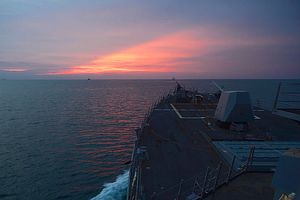A U.S. Navy warship joined two Japan Maritime Self-Defense Force (JMSDF) for a cooperative deployment in the strategic Malacca Strait on May 18.
USS William P. Lawrence, a U.S. Navy Arleigh Burke-class guided-missile destroyer, joined the MSDF’s Izumo-class helicopter carrier JS Izumo and Murasame-class destroyer JS Murasame in the Malacca Strait.
All three allied vessels had been involved in prior activities in disputed waters in the South China Sea, where they joined vessels from the Indian Navy and the Philippine Navy as well.
The U.S. Navy and MSDF vessels “participated in communication drills, working together to increase their efficiency and interoperability while at sea,” a statement released by the U.S. Navy’s 7th Fleet noted.
“By operating, training, and exchanging with the JMSDF we are building upon our interoperability and our vital alliance,” said Cmdr. Andrew Klug, commanding officer of USS William P. Lawrence. “Seamless coordination between regional allies deters aggression and promotes regional peace, stability and prosperity.”
The United States and Japan have conducted joint activities in the South China Sea, the Western Pacific, and the Indian Ocean extensively in recent years.
The Malacca Strait is a particularly important strategic waterway in the region and is the second-busiest trade chokepoint in the world, according to the International Energy Agency.
According to the Japanese Ministry of Foreign Affairs, 90 percent of the oil imported by Japan from the Middle East and elsewhere transits the Malacca Strait.
The Malacca Strait area has been a particular area of concern for regional piracy as well, due to the massive commercial shipping volume that transits the area.
The strait runs between peninsular Malaysia and the Indonesian island of Sumatra. Near Singapore, the strait reaches its narrowest point, where it runs just 1.5 nautical miles wide.
Japan, in particular, sees the Malacca Strait as an important chokepoint connecting not only the Middle East, but also the southeastern coast of the African continent to Asia-bound sea lanes.
Both Japan and the United States have emphasized the Indo-Pacific region in recent strategic documents. The Trump administration is expected to announce a strategy for the region at the upcoming 18th Shangri-La Dialogue in Singapore.
In August 2016, Japanese Prime Minister Shinzo Abe announced Tokyo’s “free and open Indo-Pacific strategy” during a speech in Kenya.
“What will give stability and prosperity to the world is none other than the enormous liveliness brought forth through the union of two free and open oceans and two continents,” he said.
“Japan bears the responsibility of fostering the confluence of the Pacific and Indian Oceans and of Asia and Africa into a place that values freedom, the rule of law, and the market economy, free from force or coercion, and making it prosperous,” Abe had added at the time.

































